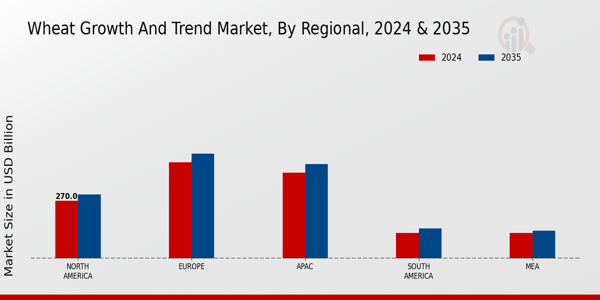Rising Global Population
The Global Global Wheat Market Industry is experiencing heightened demand driven by the increasing global population, which is projected to reach approximately 9.7 billion by 2050. This demographic shift necessitates a substantial rise in food production, with wheat being a staple crop for many regions. As urbanization continues, the consumption of wheat-based products is likely to surge, thereby propelling market growth. In 2024, the market is valued at 1359.6 USD Billion, reflecting the urgent need to enhance agricultural productivity to meet the dietary needs of a growing populace.
Market Trends and Projections
The Global Global Wheat Market Industry is characterized by various trends and projections that highlight its potential trajectory. Current analyses indicate a market value of 1359.6 USD Billion in 2024, with expectations to reach 1500 USD Billion by 2035. The anticipated CAGR of 0.9% from 2025 to 2035 suggests a gradual but steady growth pattern, influenced by factors such as population dynamics, dietary shifts, and technological advancements. These trends provide a comprehensive overview of the market's future, indicating areas of opportunity and potential challenges.
Shifts in Dietary Preferences
Changes in dietary preferences, particularly in developing nations, are influencing the Global Global Wheat Market Industry. As incomes rise, consumers are increasingly opting for wheat-based products, such as bread and pasta, which are perceived as affordable and versatile food sources. This trend is particularly evident in regions like Asia and Africa, where wheat consumption is on the rise. The market's growth trajectory suggests that by 2035, it could reach 1500 USD Billion, indicating a robust demand for wheat as a primary food source in diverse culinary applications.
Government Policies and Support
Government policies aimed at supporting the agricultural sector are significantly impacting the Global Global Wheat Market Industry. Subsidies, tariffs, and trade agreements can either bolster or hinder market dynamics. For instance, countries that prioritize wheat production through favorable policies tend to see increased output and market stability. Conversely, restrictive measures may limit trade and affect prices. As governments recognize the importance of food security, it is likely that supportive measures will continue, thereby influencing the market's growth and stability in the coming years.
Climate Change and Environmental Factors
The effects of climate change are increasingly felt within the Global Global Wheat Market Industry, as fluctuating weather patterns and extreme conditions impact wheat yields. Droughts, floods, and changing temperatures can lead to reduced production and increased volatility in supply. This unpredictability necessitates adaptive strategies among farmers and stakeholders to mitigate risks. As the industry grapples with these environmental challenges, it may drive innovation in crop resilience and sustainable practices, ultimately shaping the future landscape of the wheat market.
Technological Advancements in Agriculture
Technological innovations in agriculture are playing a pivotal role in enhancing the efficiency of wheat production within the Global Global Wheat Market Industry. Precision farming, genetically modified organisms, and advanced irrigation techniques are enabling farmers to increase yields and reduce resource wastage. These advancements not only contribute to meeting the rising demand but also support sustainable farming practices. As the industry adapts to these technologies, it is anticipated that the market will maintain a steady growth rate, with a projected CAGR of 0.9% from 2025 to 2035, reflecting the ongoing evolution of agricultural practices.























Leave a Comment